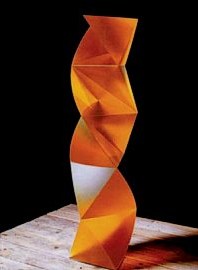Sabína Jankovičová
An interview with two artists, a couple in their personal and creative life, has been inspired by their recent achievements as well as changes in perception of glass within other artistic sectors. Recognised as a “strong” field within the spectrum of visual arts and the Slovak arts from the Cigler´s school, glass seeks new status and acknowledgement.
Štěpán Pala (*1944) was a student of the Secondary School of Glass Design in Kamenický Šenov between 1959 and 1963 and studied at the department The Glass in architecture of the AFAD in Bratislava between 1969 and 1975. Pala did galls design in architecture in the 1970s and 1980s, particularly monumental lightings and free-style optic glass design, developing the principles of Constructivism and Minimalism. Now, Pala has engaged himself into drawing, developing the structure of fractals in glass. The artist has been awarded several prizes, for example The Glass Triennial Nuremberg in 1993, The Gold Prize at the International Exhibition of Glass v Kanazawa (Japan) in 1997.
Zora Palová (1947) was a student of the Secondary School of Applied Arts in Bratislava between 1963 and 1967 and studied at the department The Glass in architecture of the AFAD in Bratislava between 1969 and 1975. Palová pursued her artistic career from geometric art, jewellery and textile to the cast glass. Between 1996 and 2003, the artist worked at the department of glass and ceramics of the University of Sunderland (GB) and created the department of glass statue there. Palová was awarded the Coburg Glass Prize in 2006, the Bavarian National Prize for creative approach to artistic glass in 2007 and the Crystal Wing in Bratislava for creative contribution.
Each of the couple has developed an individual method how to express their creative ideas and their ways are, surprisingly, opposites.
Zora: „I like shaping clay freely and then putting the shapes into glass. Fingerprints in clay would be of a similar shape in glass. Cutting one side produces a contrast of smooth and structured surfaces that I can work with later.
I do not have a great liking for glass-blowing. I am not happy that another individual does the work for me. I am in charge of every part of process when I cast statues. I do modelling and casting, too. Naturally, I do have a helping hand, however, the whole process is under my control and therefore it is my very work. I can work in collaboration with a glassblower, but what I receive is only a decorative object. I have never seen a statue from blown glass, big or small.“
Štěpán Pala has chosen an opposite direction and conducts mathematical analyses of space, transformed into drawing and glass: „Geometry has developed a minimalist approach, utilising essential shapes of sphere and tetrahedron. What I like is the simple shapes syntax. There are always new forms and shapes to improve. Fractals are typical examples of a shape utilising coincidence. Here, long row of coincidences become a law. It is controlled coincidence reminding of coincidence only if in a short row. What excites me is new forms, new connections developed by interconnecting of individual elements. I believe that a new mathematical method may carry aesthetic values. It is very hard to imagine. And, computer is the only way to picture it. Fractals have been discovered with computer visualisations, otherwise it was impossible to discover they exist.“
